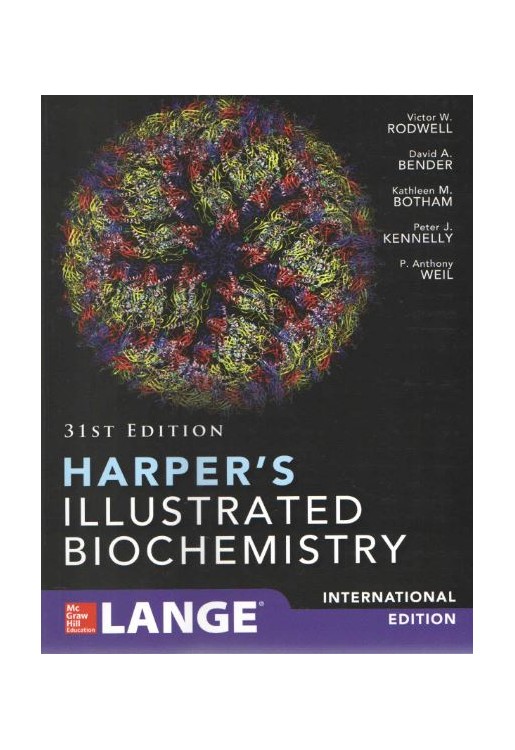Gain a full understanding of the principles of biochemistry as it relates to clinical medicine
A Doody's Core Title for 2019!
The Thirty-First Edition of Harper's Illustrated Biochemistry continues to emphasize the link between biochemistry and the understanding of disease states, disease pathology, and the practice of medicine. Featuring a full-colour presentation and numerous medically relevant examples, Harper's presents a clear, succinct review of the fundamentals of biochemistry that every student must understand in order to succeed in medical school.
All 58 chapters help you understand the medical relevance of biochemistry:
* Full-colour presentation includes more than 600 illustrations
* Case studies emphasize the clinical relevance of biochemistry
* NEW CHAPTER on Biochemistry of Transition Metals addresses the importance and overall pervasiveness of transition metals
* Review Questions follow each of the eleven sections
* Boxed Objectives define the goals of each chapter
* Tables encapsulate important information
* Every chapter includes a section on the biomedical importance of a given topic
NEW TO THIS EDITION:
* Emphasis throughout on the integral relationship between biochemistry and disease, diagnostic pathology, and medical practice
* Hundreds of references to disease states throughout
* New chapter addressing the biochemical roles of transition metals
* Many updated review questions
* Frequent tables summarizing key links to disease states
* New text on cryo-electron microscopy (cryo-EM)
* Cover picture of the protein structure of the Zika virus, solved by cryo-EM
Applauded by medical students and online reviewers for its currency and engaging style, Harper's Illustrated Biochemistry is essential for USMLE (R) review and the single-best reference for learning the clinical relevance of any biochemistry topic.
Publisher's Note: Products purchased from Third Party sellers are not guaranteed by the publisher for quality, authenticity, or access to any online entitlements included with the product.
Section I: Structures & Functions of Proteins & Enzymes
Chapter 1: Biochemistry & Medicine
Chapter 2: Water & pH
Chapter 3: Amino Acids & Peptides
Chapter 4: Proteins: Determination of Primary Structure
Chapter 5: Proteins: Higher Orders of Structure
Section II: Enzymes: Kinetics, Mechanism, Regulation, & Role of Transition Metals
Chapter 6: Proteins: Myoglobin & Haemoglobin
Chapter 7: Enzymes: Mechanism of Action
Chapter 8: Enzymes: Kinetics
Chapter 9: Enzymes:Regulation of Activities
Chapter 10: The Biochemical Roles of Transition Metals
Section III: Bioenergetics
Chapter 11: Bioenergetics: The Role of ATP
Chapter 12: Biologic Oxidation
Chapter 13: The Respiratory Chain & Oxidative Phosphorylation
Section IV: Metabolism of Carbohydrates
Chapter 14: Overview of Metabolism & the Provision of Metabolic Fuels
Chapter 15:Carbohydrates of Physiological Significance
Chapter 16: The Citric Acid Cycle: The Central Pathway of Carbohydrate, Lipid, & Amino Acid Metabolism
Chapter 17: Glycolysis & the Oxidation of Pyruvate
Chapter 18: Metabolism of Glycogen
Chapter 19: Gluconeogenesis & the Control of Blood Glucose
Chapter 20: The Pentose Phosphate Pathway & Other Pathways of Hexose Metabolism
Section V: Metabolism of Lipids
Chapter 21: Lipids of Physiologic Significance
Chapter 22: Oxidation of Fatty Acids: Ketogenesis
Chapter 23: Biosynthesis of Fatty Acids & Eicosanoids
Chapter 24: Metabolism of Acylglycerols & Sphingolipids
Chapter 25: Lipid Transport & Storage
Chapter 26: Cholesterol Synthesis, Transport, & Excretion
Section VI: Metabolism of Proteins & Amino Acids
Chapter 27: Biosynthesis of the Nutritionally Nonessential Amino Acids
Chapter 28: Catabolism of Proteins & of Amino Acid Nitrogen
Chapter 29: Catabolism of the Carbon Skeletons of Amino Acids
Chapter 30: Conversion of Amino Acids to Specialized Products
Chapter 31: Porphyrins & Bile Pigments
Section VII: Structure, Function, & Replication of Informational Macromolecules
Chapter 32: Nucleotides
Chapter 33: Metabolism of Purine & Pyrimidine Nucleotides
Chapter 34: Nucleic Acid Structure & Function
Chapter 35: DNA Organisation, Replication, & Repair
Chapter 36: RNA Synthesis, Processing, & Modification
Chapter 37: Protein Synthesis & the Genetic Code
Chapter 38: Regulation of Gene Expression
Chapter 39: Molecular Genetics, Recombinant DNA, & Genomic Technology
Section VIII: Biochemistry of Extracellular & Intracellular Communication
Chapter 40: Membranes: Structure & Function
Chapter 41: The Diversity of the Endocrine System
Chapter 42: Hormone Action & Signal Transduction
Section IX: Special Topics (A)
Chapter 43: Nutrition, Digestion, & Absorption
Chapter 44: Micronutrients: Vitamins & Minerals
Chapter 45: Free Radicals & Antioxidant Nutrients
Chapter 46: Glycoproteins
Chapter 47: Metabolism of Xenobiotics
Chapter 48: Clinical Biochemistry
Section X: Special Topics (B)
Chapter 49: Intracellular Traffic & Sorting of Proteins
Chapter 50: The Extracellular Matrix
Chapter 51: Muscle& the Cytoskeleton
Chapter 52: Plasma Proteins & Immunoglobulins
Chapter 53: Red Blood Cells
Chapter 54: White Blood Cells
Section XI: Special Topics (C)
Chapter 55: Haemostasis & Thrombosis
Chapter 56: Cancer: An Overview
Chapter 57: The Biochemistry of Aging
Chapter 58: Biochemical Case Histories


